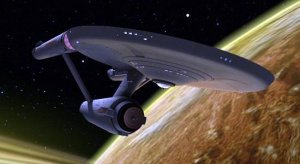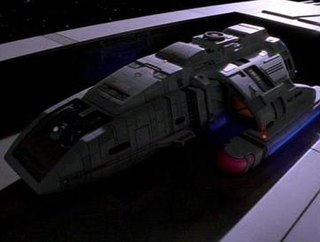
Enterprise or USS Enterprise is the name of several fictional spacecraft, some of which are the main craft and setting for various television series and films in the Star Trek science fiction franchise. The most notable were Captain James T. Kirk's USS Enterprise (NCC-1701) from the original 1960s television series, and Captain Jean-Luc Picard's USS Enterprise (NCC-1701-D) from Star Trek: The Next Generation.
In the Star Trek fictional universe, shields refer to a 23rd and 24th century technology that provides starships, space stations, and entire planets with limited protection against damage. They are sometimes referred to as deflectors, deflector shields, and screens.

Zefram Cochrane is a fictional character in the Star Trek universe. Created by writer Gene L. Coon, the character first appeared in the 1967 Star Trek episode "Metamorphosis", in which he was played by Glenn Corbett. James Cromwell later played Cochrane in the 1996 feature film Star Trek: First Contact and the 2001 Star Trek: Enterprise pilot, "Broken Bow". Footage of Cromwell from Star Trek: First Contact was used in the Enterprise episode "In a Mirror, Darkly Part I".

In the Star Trek fictional universe, LCARS is a computer operating system. Within Star Trek chronology, the term was first used in the Star Trek: The Next Generation series.
Robert T. April is a fictional character in the Star Trek universe. April is listed in the Star Trek Chronology, The Star Trek Encyclopedia and at startrek.com as the Enterprise's first commanding officer, preceding Captain Christopher Pike.

Hikaru Kato Sulu is a fictional character in the Star Trek media franchise. Originally known simply as "Sulu", he was portrayed by George Takei in the original Star Trek series. Sulu also appears in the animated Star Trek series, the first six Star Trek movies, one episode of Star Trek: Voyager, and in numerous books, comics, and video games. Sulu's first name, "Hikaru", appeared in a 1981 novel well over a decade after the original series had ended. John Cho assumed the role of the character in both the 2009 film Star Trek and its sequels, Star Trek Into Darkness and Star Trek Beyond.

The Star Trek Encyclopedia: A Reference Guide to the Future is a 1994 encyclopedia of in-universe information from the Star Trek television series and films. It was written by Michael Okuda and Denise Okuda, who were production staff on Star Trek: The Next Generation, Star Trek: Deep Space Nine and Star Trek: Voyager and Debbie Mirek. It was illustrated by Doug Drexler.
In the Star Trek franchise, the Klingon Empire makes use of several classes of starships. As the Klingons are portrayed as a warrior culture, driven by the pursuit of honor and glory, the Empire is shown to use warships almost exclusively and even their support ships, such as troop transports and colony ships, are armed for battle. This contrasts with the exploration and research vessels used by Starfleet, the protagonists of the franchise. The first Klingon ship design used in The Original Series, the D7-class battlecruiser, was designed by Matt Jefferies to evoke a shape akin to that of a manta ray, providing a threatening and instantly recognizable form for viewers. The configuration of Jefferies's design featured a bulbous forward hull connected by a long boom to a wing-like main hull with the engine nacelles mounted on each wingtip. Though a variety of Klingon ships have appeared in Star Trek, their design generally conforms to this style. Most Klingon vessels were physically built as scale models, although later computer-generated imagery was used to create the models. In recent years, many of the original studio models have been sold at auctions.

Runabouts are a class of small, multi-purpose starships in the Star Trek science-fiction franchise, primarily the television series Star Trek: Deep Space Nine, which aired on syndicated television between 1993 and 1999. They were the primary means of transport for the crew of the DS9 station. As the station had three launch pads, its normal contingent of runabouts numbered three, though a high rate of loss often reduced that number until a new ship or ships could be assigned.
This article discusses the fictional timeline of the Star Trek franchise. The franchise is primarily set in the future, ranging from the mid-22nd century to the late 24th century with the third season of Star Trek: Discovery jumping forward to the 32nd century. However the franchise has also outlined a fictional future history of Earth prior to this, and, primarily through time travel plots, explored both past and further-future settings.
Earth Spacedock is a fictional space station orbiting Earth in the Star Trek universe, designed originally by David Carson and Nilo Rodis of Industrial Light and Magic in the 1980s. It is large enough to contain several starships of that fictional universe, and in real life the Spacedock consisted of a series of sets, miniatures, and designs that were used for various films and television shows in the 1980s and 1990s. Written spacedock, it is first seen in the 1984 theater film Star Trek III: The Search for Spock, and subsequently in the fourth, fifth, and sixth Star Trek movies.
The Star Trek franchise has produced a large number of novels, comic books, video games, and other materials, which are generally considered non-canon.
The Star Trek canon is the set of all canonical material in the Star Trek universe. The official Star Trek website defines canon as comprising the television series and feature films of the franchise.

Michael Okuda is an American graphic designer best known for his work on Star Trek.
Richard Michael Sternbach is an illustrator who is best known for his space illustrations and his work on the Star Trek television series.

Star Trek: The Next Generation: Technical Manual is a paperback reference guide detailing the inner and other workings of the fictional Federation starship Enterprise-D and other aspects of technology that appeared in the television series Star Trek: The Next Generation.

Voyages of Imagination: The Star Trek Fiction Companion (2006) is a reference work by Jeff Ayers published by Pocket Books. The book contains entries on the production and publication of Star Trek tie-in novels published from 1967 to 2006. Included are brief synopses of the plots for each book.

The Star Trek franchise features many spacecraft. Various space vessels make up the primary settings of the Star Trek television series, films, and expanded universe; others help advance the franchise's stories. Throughout the franchise's production, spacecraft have been depicted by numerous physical and computer-generated models. Producers worked to balance often tight budgets with the need to depict convincing, futuristic vessels.










